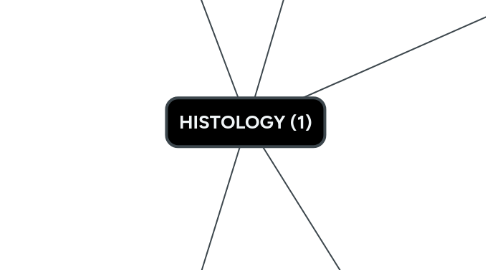
1. Muscle tissue
1.1. Muscle tissue is a soft tissue that composes muscles in animal bodies, and gives rise to muscles' ability to contract.
1.1.1. Types of muscle tissue
1.1.2. Smooth Muscle
1.1.2.1. The smooth muscle in the uterus helps a woman to push out her baby. Helps to flow blood in arteries and move food through digestive tract.
1.1.2.2. LOCATION & ASSOCIATED ORGANS °Small & Large intestine °Stomach
1.1.3. Cardiac Muscle
1.1.3.1. Responsible for keeping the heart pumping and relaxing normally.
1.1.3.2. LOCATION & ASSOCIATED ORGANS °Walls of the heart
1.1.4. Skeletal Muscle
1.1.4.1. Maintain body posture.Move the skeleton. Support soft tissues.
1.1.4.2. LOCATION & ASSOCIATED ORGANS °Skeletal muscle is found between bones, and uses tendons to connect the epimysium to the periosteum, or outer covering, of bone.
2. Connective tissue
2.1. Tissue that supports, protects, and gives structure to other tissues and organs in the body.
2.1.1. Types of connective tissues
2.1.2. Loose connective tissue
2.1.2.1. connect epithelia to underlying body structures, link muscles to bones, and hold joints together.
2.1.2.2. LOCATION & ASSOCIATED ORGANS °Nervous system
2.1.3. Dense Connective tissue
2.1.3.1. The compact arrangement of collagen fibres serves to resist stretch. Bands of such connective tissue are used to join bones and as tendons to connect muscles to bones.
2.1.3.2. LOCATION & ASSOCIATED ORGANS °dermis layer of the skin
2.1.4. Adipose tissue
2.1.4.1. Energy storing, hormone production, thermal isolation
2.1.4.2. LOCATION & ASSOCIATED ORGANS °Beaneth the skin °Around internal organs
2.1.5. Reticular connective tissue
2.1.5.1. Their function is to form a stroma and provide structural support, such as that in the lymphoid organs, e.g. red bone marrow, spleen, and lymph node stromal cells.
2.1.5.2. LOCATION & ASSOCIATED ORGANS °Kidney °Spleen °Lymph nodes °Bone marrow
3. Nervous tissue
3.1. Nervous tissue, also called neural tissue, is the main tissue component of the nervous system.
3.1.1. Types of nervous tissue
3.1.2. Neurons
3.1.2.1. Stimulates muscle contraction, creates awareness of the environment and plays a major role in emotions, memory and reasoning.
3.1.2.2. LOCATION & ASSOCIATED ORGANS °Brain °Spinal Cord °Nerves
3.1.3. Neuroglia
3.1.3.1. LOCATION & ASSOCIATED ORGANS °Central Nervous system °Peripheral Nervous system
4. Epithelial tissue
4.1. Protection from the environment, coverage, secretion and excretion, absorption, and filtration
4.1.1. Types of epithelial tissue
4.1.2. SIMPLE EPITHELIUM
4.1.3. Simple Cuboidal Epithelium
4.1.3.1. Single and tall layer of cells.Secretion and absorption are the main function of cuboidal epithelium.
4.1.3.2. LOCATION & ASSOCIATED ORGANS °Ovaries °Lining of Nephrons °Renal tubules °Eyes °Salivary Glands °Thyroid Follicles
4.1.4. Simple Squamos Epithelium
4.1.4.1. Facilitate diffusion of gasses and small molecules.
4.1.4.2. LOCATION & ASSOCIATED ORGANS °Alveoli of lungs °Lining of Blood Vessels °Capillaries °Lungs °Liver
4.1.5. Simple Columnar Epithelium
4.1.5.1. Lines the small intestine and absorbs nutrients from the lumen of the intestine.
4.1.5.2. LOCATION & ASSOCIATED ORGANS °Digestive tract ° Stomach °Small & Large Intestine
4.1.6. STRATIFIED
4.1.7. Stratified cuboidal Epithelium
4.1.7.1. Creates impermeable barrier.Makes multiple membrane junctions between adjacent cells.
4.1.7.2. LOCATION & ASSOCIATED ORGANS °Sweat glands °Mammary glands °Circumanal glands °Salivary Glands
4.1.8. Stratified Squamous Epithelium
4.1.8.1. Lining tissue which provides protection for underlying tissues.
4.1.8.2. LOCATION & ASSOCIATED ORGANS °Lines the esophagus °Mouth °Vagina
4.1.9. Stratified Columnar Epithelium
4.1.9.1. Simple columnar epithelia with microvilli secrete digestive enzymes and absorb digested food.
4.1.9.2. LOCATION & ASSOCIATED ORGANS °The male urethra and the ducts of some glands
4.1.10. Transitional Epithelium
4.1.10.1. Lines urinary bladder and portions of ureters and urethra. It allows the urinary organs to stretch to hild a variable amount of fluid without returning, while still serving as a protective lining.
4.1.10.2. LOCATION & ASSOCIATED ORGANS °Urinary bladder °Ureter °Urethra °Ducts of prostate glands
